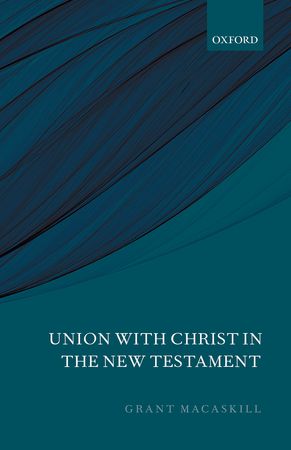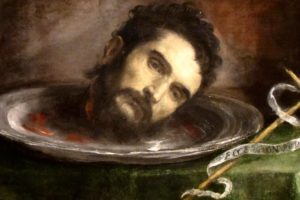Long a pillar of Eastern Orthodox theology, theosis has been generating increasing interest across denominational lines in recent years. In Union with Christ in the New Testament, Grant Macaskill (University of St Andrews) utilizes an exegetical, historical, and theological approach to offer significant biblical insights that have far-reaching implications for the continuing discussion.
Macaskill’s primary thesis is that covenant provides the appropriate framework for understanding how the New Testament represents union with God through Christ. Closely related to covenant in the NT is a series of themes that include temple imagery—especially, but not solely, in description of the church—and the closely related “glory” language, the integration of Jesus’ divinity and humanity, the metaphor of adoption and sonship, the role of the Holy Spirit, the importance of divinely revealed wisdom, the role of the sacraments, and the nature of atonement, all of which receive engagement in Macaskill’s expansive study. This breadth of view is distinctive of Macaskill’s work and is one of its key strengths. In a refreshing change from the atomizing tendencies of many biblical studies, Macaskill argues convincingly for the necessity of an integrative approach across the canon of the NT.
After an introductory survey of recent scholarship that explains how diverse topics including the New Perspective, narrative theology, Adam Christology, the pistis Christou debate, and recent “apocalyptic” interpretations all have implications for understanding unity with Christ, Macaskill summarizes Eastern Orthodox views, showing how theosis functions as a comprehensive doctrine tied to the purpose of God for the glorification of creation (p. 45). Because of this technical sense, its roots in Platonic philosophy, and its varied use among theologians, Macaskill concludes that the term theosis is unhelpful for the descriptive task of biblical studies (p. 54). From here, he engages with the church fathers, highlighting that the earliest Christians were intentional with the way they described union with Christ, taking care not to impugn the uniqueness of God (p. 75); they spoke of deification in relational terms, and particularly of “filiation” or sonship (p. 73). Next, Macaskill traces a tradition of union through theological figures stretching from the Reformation to Karl Barth, highlighting their understanding of Jesus’ divinity, covenantal theology, and their (admittedly varied) understanding of the presence of Christ in the sacraments (p. 99).
The next two chapters examine the Jewish background of the concept. Macaskill helpfully insists on the continuity between covenantal and apocalyptic thought, areas often contrasted in biblical research (p. 114-121). Through interaction with primary texts, Macaskill demonstrates that the use of “glory” language, which some trace back to Adam’s initial state, is more appropriately associated with the controlling symbols of Jewish faith: temple and Torah (p. 143), thus suggesting that the Adamic background is less important to early Christology than the full narrative of Israel.
The final chapters, the heart of Macaskill’s book, trace the complex of covenantal themes throughout the NT writings. Macaskill focuses on the way the temple functions as a metaphor for the church, beginning with Ephesians and then moving to the undisputed Pauline texts, the Petrine texts, and the book of Acts. The next chapter examines other temple imagery in the NT, focusing on the Gospel of John, Hebrews, and Revelation, noting that while their presentation of the temple imagery is distinct from the ecclesiastical one examined earlier, these texts retain a similar position that highlights divine presence with the church. The next chapter looks at the function of baptism and the Eucharist in the NT texts, concluding that they function within a covenantal framework that invites the church to participate in the continuing covenantal narrative. The final three chapters of the exegetical section examine other participatory elements in the Paul, John, and the rest of the NT.
A natural result of such an extensive exegetical approach is the opportunity to disagree about specific exegetical decisions. For example, the occasional appeal to the ancient Jewish reading practice of gezera shewa to link various passages from the Old Testament based on a single key term (e.g., p. 152, footnote 15) seems insufficient on its own for demonstrating that certain passages should function as conceptual parallels. However, such disagreements certainly do not detract from the comprehensive evidence presented in support of Macaskill’s thesis and are, in fact, testimony to the inclusion of substantial exegetical data.
Another consequence of the synthetic methodology is that it can be difficult to keep track of exactly how the various themes hold together into a coherent whole, especially for those unfamiliar with the broader discussions of NT scholarship. Again, this ultimately does not detract from the contribution of the book, and it results from Macaskill’s insistence that the individual voices of the various NT writings be heard. Ultimately, the many benefits of such an inclusive and synthetic study far outweigh these minor quibbles.
Union with Christ in the New Testament is a important book for understanding an increasingly important issue in contemporary NT studies: human union with God. Whether one agrees or disagrees with the exegesis, this covenantal framework must be accounted for in any subsequent discussions concerning theosis, participation, and union with Christ.
The Bottom Line: Macaskill’s thesis is that covenantal relationship forms the framework of the NT portrayal of union with Christ. This book is not to be missed by those studying Christian theosis or NT theology more broadly.
Review by Eric Covington
University of St. Andrews





1 Comment
Leave your reply.